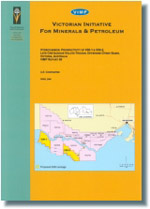VIMP Report 66 - Hydrocarbon prospectivity of V00-1 and V00-2, Late Cretaceous Voluta Trough, offshore Otway Basin
 |
| |||||
Product description:Download The downloadable version of this report is supplied in PDF format. Executive Summary Two Commonwealth offshore blocks are available this year in the Victorian part of the Otway Basin: V00-1 and V00-2. The two blocks are located in the Late Cretaceous Voluta Trough and are relatively underexplored. V00-1 is located approximately 325 km WSW of the state capital, Melbourne (population 3,370,000), in the far west of Victoria next to the South Australian border. The block consists of 35 graticules and covers an area of about 1868 km². It is bounded to the northeast by the state three nautical mile zone, and to the east by VIC/P35. Approximately 83% of the block lies in water less than 200 m deep, with water depth across the block increasing from about 20 m along the three nautical mile zone boundary to about 500 m along its southwestern edge. The nearest major population centre is Portland (pop 9,600) approximately 20 km to the ENE of the area. Portland is a deepwater port that has excellent road and rail access. The city supports several light industries, as well as a large aluminium smelter, and can be used as a base for offshore operations. V00-2 is located in the eastern part of the offshore Otway Basin about 250 km WSW of Melbourne. The block consists of 30 graticules and covers an area of about 1874 km². It is broadly rectangular in shape, with its long axis oriented NW-SE, and is bounded to the west by VIC/P35, to the north by VIC/P44, and to the east by VIC/RL7 and VIC/P43. Water depths across the block increase towards the southwest, ranging from 50 m along the northeastern edge, to 1000 m along the southwestern margin. Around 80% of the block is located in water less than 200 m deep. The nearest major population centre is the City of Geelong (pop 153,000), approximately 175 km to the ENE. Geelong is a large port and the location of a major petroleum refinery. Only six wells have been drilled in these two blocks so far; four in V00-1 [Voluta-1 (1967), Discovery Bay-1 (1982), Bridgewater Bay-1 (1983), Normanby-1 (1986)] and two in V00-2 [Nautilus-1 (1967), Triton-1 (1980)]. All six wells proved dry and were plugged and abandoned upon completion. Despite this lack of success, the Voluta Trough is still thought to have significant hydrocarbon potential as it has only been lightly explored in the past, plus numerous oil and gas shows have been encountered in blocks to the north of V00-1 and V00-2 over the past two decades; culminating in 1993 with the Minerva (575 Bcf GIP) and La Bella (210 Bcf GIP) gas/condensate discoveries (Luxton et al., 1995) which were later secured by BHP Petroleum in Retention Leases in late 1997–early 1998. These discoveries indicate an active petroleum system is operating in the offshore Otway Basin. Geochemical data indicate the gas is derived from the Lower Cretaceous (Aptian-Albian) Eumeralla Formation. This unit, which is largely gas-prone, underlies the entire Otway Basin, and is currently gas mature in V00-1 and V00-2. Potential play fairways identified in V00-1 include (in ascending stratigraphic order) the Late Cretaceous Waarre, Flaxmans and Paaratte formations, the Timboon Sandstone (Sherbrook Group), and the Early Tertiary Pebble Point and Dilwyn formations (Wangerrip Group). Geohistory modelling (Mehin & Link, 1997) indicates peak hydrocarbon expulsion in this block occurred between 95 and 85 Ma, with a second minor event between 20 and 0 Ma. The latter event is widely thought to be the source of gas in Minerva, La Bella and Port Campbell gas fields. Potential play fairways in V00-2 are limited to the Waarre Formation. Other offshore play fairways such as the Flaxmans Formation, Paaratte Formation, Timboon Sandstone, Pebble Point and Dilwyn formations are largely absent in this block. Nevertheless, preliminary geohistory modelling of Nautilus-1 and Triton-1 by MPV (Dr. K. Mehin, pers. comm.) suggests the block still has significant hydrocarbon potential due to the thickness of the Late Tertiary carbonate-rich Nirranda and Heytesbury groups (> 1500 m), as rapid loading in the Late Tertiary would have pushed the then oil-mature portions of the Eumeralla Formation into the gas window (c.f. La Bella-1 and Minerva-1). In summary, the two blocks covered in this report are still thought to have significant hydrocarbon. This potential is further enhanced by the close proximity of the blocks to the Victorian gas market. Presently, approximately 200 km of gas pipeline network exists across the Victorian part of the Otway Basin. The gas is sourced from the Port Campbell gas fields and supplies Cobden, Warrnambool, Hamilton and Portland. An additional 130 km of gas pipeline has also just been constructed in order to expand the gas pipeline network back to Colac, Winchelsea and Lara. Applications for the acreage closed November 2, 2000. Bibliographic reference Constantine, A.E., 2000. Hydrocarbon prospectivity of V00-1 and V00-2, Late Cretaceous Voluta Trough, offshore Otway Basin. Victorian Initiative for Minerals and Petroleum Report 66. Department of Natural Resources and Environment. | ||||||

